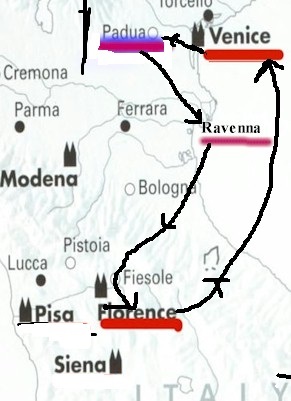ITALY 2008
Day
3, FRIDAY, May 9th
PADUA
It was late when we
went to sleep after the late night concert…sometime after 1:00 am. We
set the alarm for 8:00 but sleep a little later.
We didn’t have breakfast until 9:30.
We took our TomTom GPS out to the plaza for a test.
It was slow but it worked. We
then starting walking towards Church Church of the Eremitani (the Hermit church)
and Scrovengni Chapel (the Arena Chapel) and on another ten minutes to the train
station. We had asked the desk clerk
at the hotel to call Avis about our rental car.
They had said we couldn’t get it until 10:00 am but we had reserved it
for 8:30 am. We had a hard time
communicating between the desk clerk and person at Avis, so we decided walked to
the train station to talk to Avis. The
office was not at the train station as advertised but about ten blocks further.
So we had a good hike. We saw a lot of the more contemporary sections of
Padua. The train station itself was
very interesting. The lady at Avis
finally said that we could have our car at 8:30.
We walked back towards our hotel and found a nice sidewalk café
opposite the Hermit church. We
sat next to an older couple (about our age) from London.
We had an interesting conversation. He
had written one book and was working on a second one about art in his church
compared to the great art in Italian and other churches.
They invited us to visit them if we came to London again.
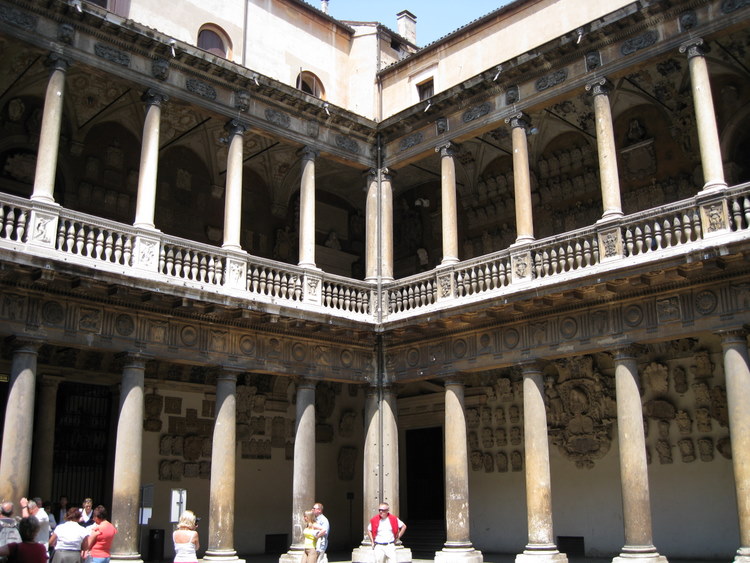
After lunch we walked to the University of Padua for a tour
that we had booked yesterday. The
University was founded in 1222. It
is now a large complex of ancient and modern buildings.
Our guide gave the tour speaking first in English and then in Italian.
The upper loggia leads to the Hall of the Faculty of Medicine.
On the walls are portraits of famous doctors.
From there we went into the Anatomical Theatre, which was built in 1594
and is the first permanent anatomical theater to be built in the world.
It is like a cone turned inside-out and is divided into six wooden
ellipses of decreasing dimensions. She showed us the famous operating theater
from the bottom but not the top. No pictures were allowed. The second stop was a
large classroom – The Room of Forty where there are portraits of famous
students and Galileo’s chair. Galileo was chair of the department of
mathematics from 1592 to 1610. Our
tour ended in a beautiful lecture hall with a lot of frescos.
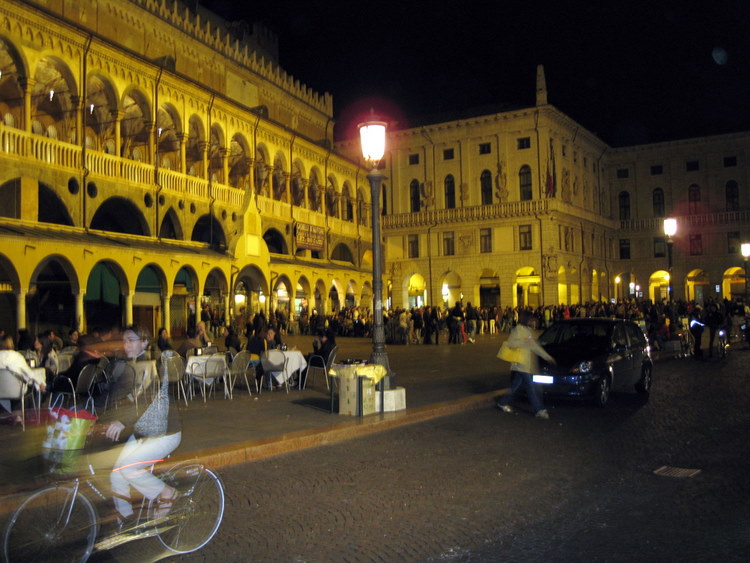
From there we
walked over to the Ragione Palazzo Salon/law court.
It is the building where the markets are on each side.
This structure, built from 1218 to 1219, was the Palace of the Comune in
the age of the first Lombardic League. It
was expanded in the early 1300’s. In
1420 it was damaged by fire and again restored.
A single hall was made of the two upper rooms.

It measures 258 ft
by 88 ft. It was a huge room with the walls covered with Fresco, some by Giotto.
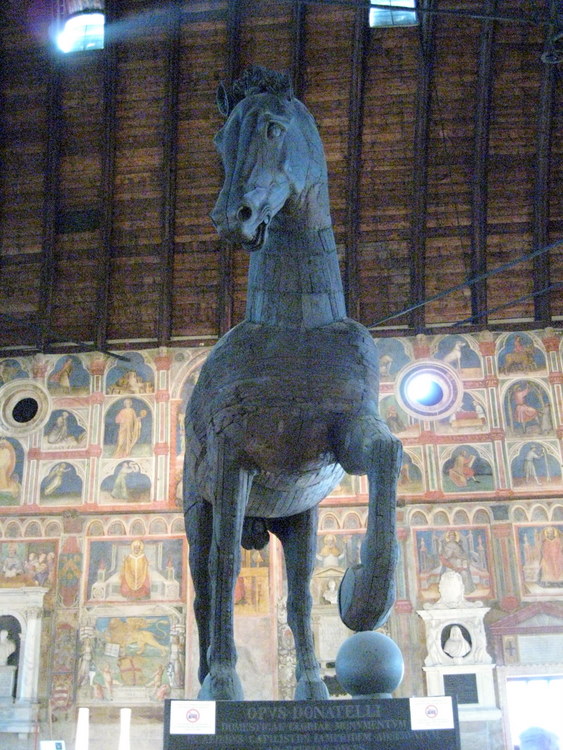
At one end was a very large wooden horse. This horse was
transferred here in 1837 from the Emo Capodilista Palace.
It has been falsely attributed to Donatello.
There was a display of gems and jewelry.
It was a fascinating building.
After spending a
lot of time in the Ragione Palazzo, we stopped in a nice outside café for
drinks and snacks. While we were
there, my wife checked her phone and found she had a voice message from Verizon
about my cell phone. A TRAVEL HINT- I would advise everyone who travels abroad to have a
cell phone. Each person should have
one in the event that they get separated. In
our case we also needed a phone to link up to our friends when we arrived in
Florence. Most phone companies, ours
is Verizon, have a special phone that they will send to your free or at a
minimal fee which has Europeans access at a reasonable cost. At the end of the
trip it is mailed back to the company. When
we arrived in Padua, my phone would not work, and we were unable to contact
Verizon, so we called my wife called her sister in Texas and asked her to
contact Verizon and have them call my wife’s cell phone to tell us how to
correct the problem with my phone. The voice message told how to contact Verizon.
We called them back, and they were
able to correct the problem with the satellite connection.
It was amazing how they did that. They were in the states and we were in
Europe!!
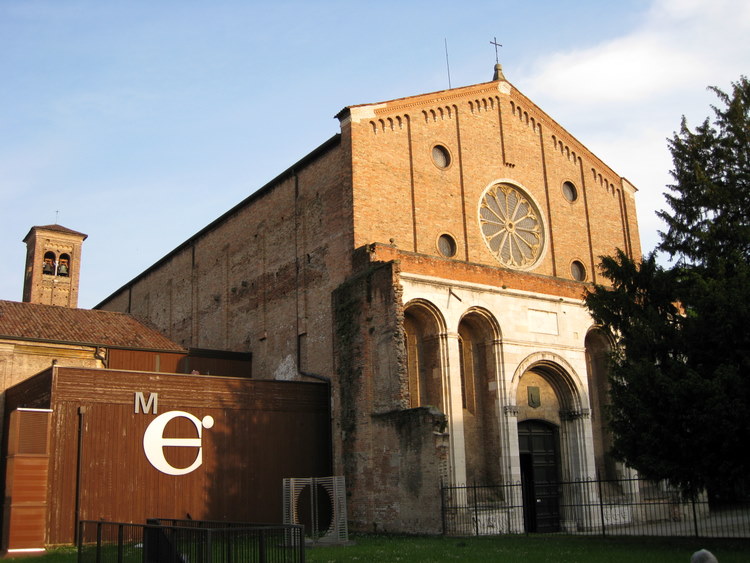 Then we went back to the Church of the Eremitani
which is also called Hermit
church. It didn’t open in the afternoon until 4:30. This church dates back to
1276. It had been built for the
Order of the Eremitani Brotherhood. The
architecture is 13th century mid-Veneto.
The upper part of the facade is in fired brick. Underneath the sloping roof are small hanging arches. In the center of
four and a half pilaster strips is a rose window with two smaller round windows
(eyes) on either side in the center to adjacent pilasters.
The lower part is in stone, and lowest part has no decorations – only
pilaster strips and high windows.
Then we went back to the Church of the Eremitani
which is also called Hermit
church. It didn’t open in the afternoon until 4:30. This church dates back to
1276. It had been built for the
Order of the Eremitani Brotherhood. The
architecture is 13th century mid-Veneto.
The upper part of the facade is in fired brick. Underneath the sloping roof are small hanging arches. In the center of
four and a half pilaster strips is a rose window with two smaller round windows
(eyes) on either side in the center to adjacent pilasters.
The lower part is in stone, and lowest part has no decorations – only
pilaster strips and high windows.

Inside, the main nave ends in a central apse and two small
apses on either side. It has a
wooden boxed-in ceiling.

It had been bombed and almost destroyed during WWII.
Parts of some of the frescoes were still on the wall, and others were being
restored

.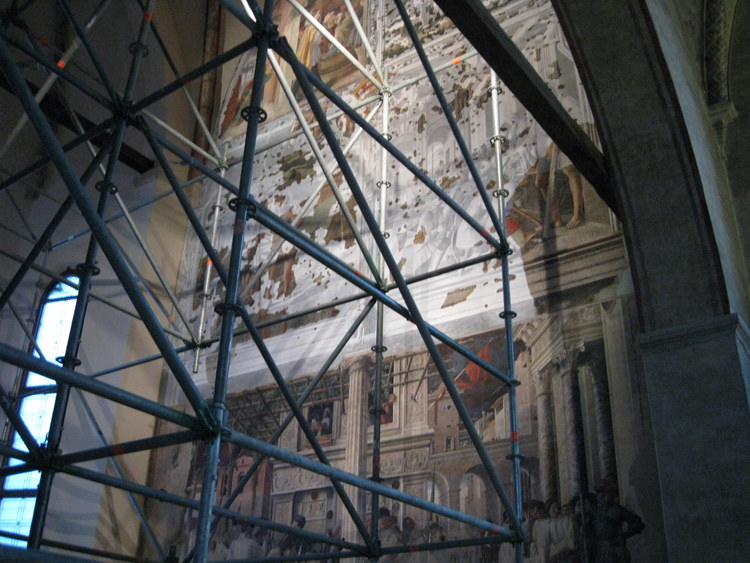 In one chapel,
the drawing on the wall of the previously damaged fresco could be seen.
They were just beginning to apply paint to various small areas. We
visited a small chapel and participated in the Mass that was being sParts
of some of fresco were still on the walls and others
aid.
In one chapel,
the drawing on the wall of the previously damaged fresco could be seen.
They were just beginning to apply paint to various small areas. We
visited a small chapel and participated in the Mass that was being sParts
of some of fresco were still on the walls and others
aid.
Next
door was the Scrovegni
Chapel, commonly called the Arena Chapel because it
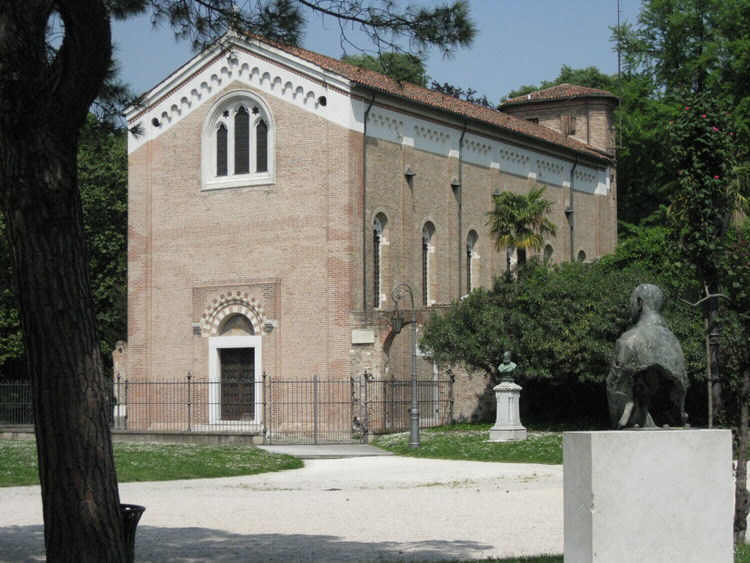 is
in the garden of a former Roman Arena. The
chapel is famous because Giotto was commissioned by Henry Scrovegni to fresco it
with the story of Mary and Christ. It
is the best conserved fresco work of Giotto.
Only 25 people are allowed in at a time for a 15 minute visit.
We had reserved tickets some months before on the internet.
Several people that I talked to in my classes could not even get a ticket
which was very disappointing. SO ORDER ON LINE BEFORE GOING!!!
is
in the garden of a former Roman Arena. The
chapel is famous because Giotto was commissioned by Henry Scrovegni to fresco it
with the story of Mary and Christ. It
is the best conserved fresco work of Giotto.
Only 25 people are allowed in at a time for a 15 minute visit.
We had reserved tickets some months before on the internet.
Several people that I talked to in my classes could not even get a ticket
which was very disappointing. SO ORDER ON LINE BEFORE GOING!!!
Before
entering the Arena Chapel, purses, back packs, etc had to be checked at the
museum store. Then we had to go into
a sort of a temperature stabilization room before going into the chapel. While
this was taking place, a video about the frescos was shown.
 This cycle is even larger, more complete, and better preserved
than the famed St. Francis frescoes in Assisi. Giotto worked from 1303 to 1306
to completely cover the ceiling and walls with 38 scenes illustrating the lives
of the Virgin and of Christ from floor to ceiling. There are three bands that
cover the walls are: top right, Life of Joachim; top left, Life of the
Virgin; right center, The Childhood of Christ; left center, Christ's
Public Life; right bottom, The Passion of Christ (the third panel of
Judas kissing Christ is the best known of the entire cycle); left bottom, Christ's
Death and Resurrection. Above the entrance is the fresco of the Last
Judgment: Christ, as judge, sits in the center, surrounded by the angels and
apostles. Below him, to the right, are the blessed, while to the left, Giotto
created a terrible hell in which devils and humans are condemned to eternal
punishment. Cobalt blue is the dominant color; the
illustrations are in that typical easy-to-understand medieval comic-strip
format, but here they take on an unprecedented degree of realism and emotion. Of course no pictures were allowed. There
are a number of good websites where you can view all of the fresco.
This cycle is even larger, more complete, and better preserved
than the famed St. Francis frescoes in Assisi. Giotto worked from 1303 to 1306
to completely cover the ceiling and walls with 38 scenes illustrating the lives
of the Virgin and of Christ from floor to ceiling. There are three bands that
cover the walls are: top right, Life of Joachim; top left, Life of the
Virgin; right center, The Childhood of Christ; left center, Christ's
Public Life; right bottom, The Passion of Christ (the third panel of
Judas kissing Christ is the best known of the entire cycle); left bottom, Christ's
Death and Resurrection. Above the entrance is the fresco of the Last
Judgment: Christ, as judge, sits in the center, surrounded by the angels and
apostles. Below him, to the right, are the blessed, while to the left, Giotto
created a terrible hell in which devils and humans are condemned to eternal
punishment. Cobalt blue is the dominant color; the
illustrations are in that typical easy-to-understand medieval comic-strip
format, but here they take on an unprecedented degree of realism and emotion. Of course no pictures were allowed. There
are a number of good websites where you can view all of the fresco.
Afterwards we went back into the museum to get my wife’s
purse and bought a book about Giotto and one about Arena chapel.
It was truly a wonderful experience.
It was about 8:30 pm when we left Arena Chapel and headed back to our
hotel. We stopped at Brek’s which
is a self service Italian cafeteria
and
had dinner. There
were a number of “stations” around the dining room where you could help
yourself to pastas, made fresh while you wait, and topped with your choice of
sauce. There's a counter just for omelets made express, another for entrees and
pizza. The dessert tray had an array of cheeses, fresh fruits, fruit salads,
tarts, and cobblers. It was an enjoyable dinner.
(I forgot to write down what we ate!)
We went back to the hotel and packed a little before going to
bed.











 is
in the garden of a former Roman Arena.
is
in the garden of a former Roman Arena.
